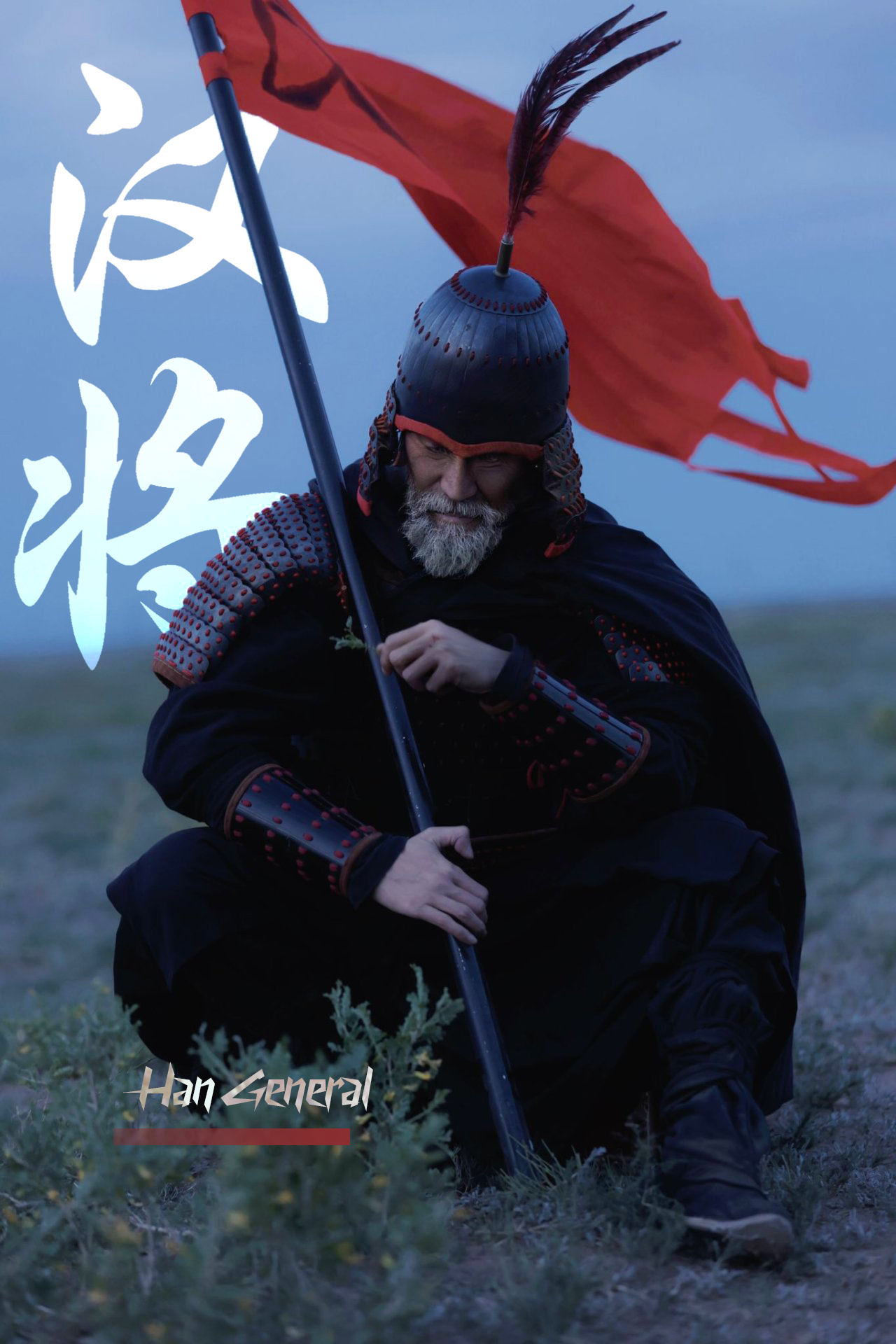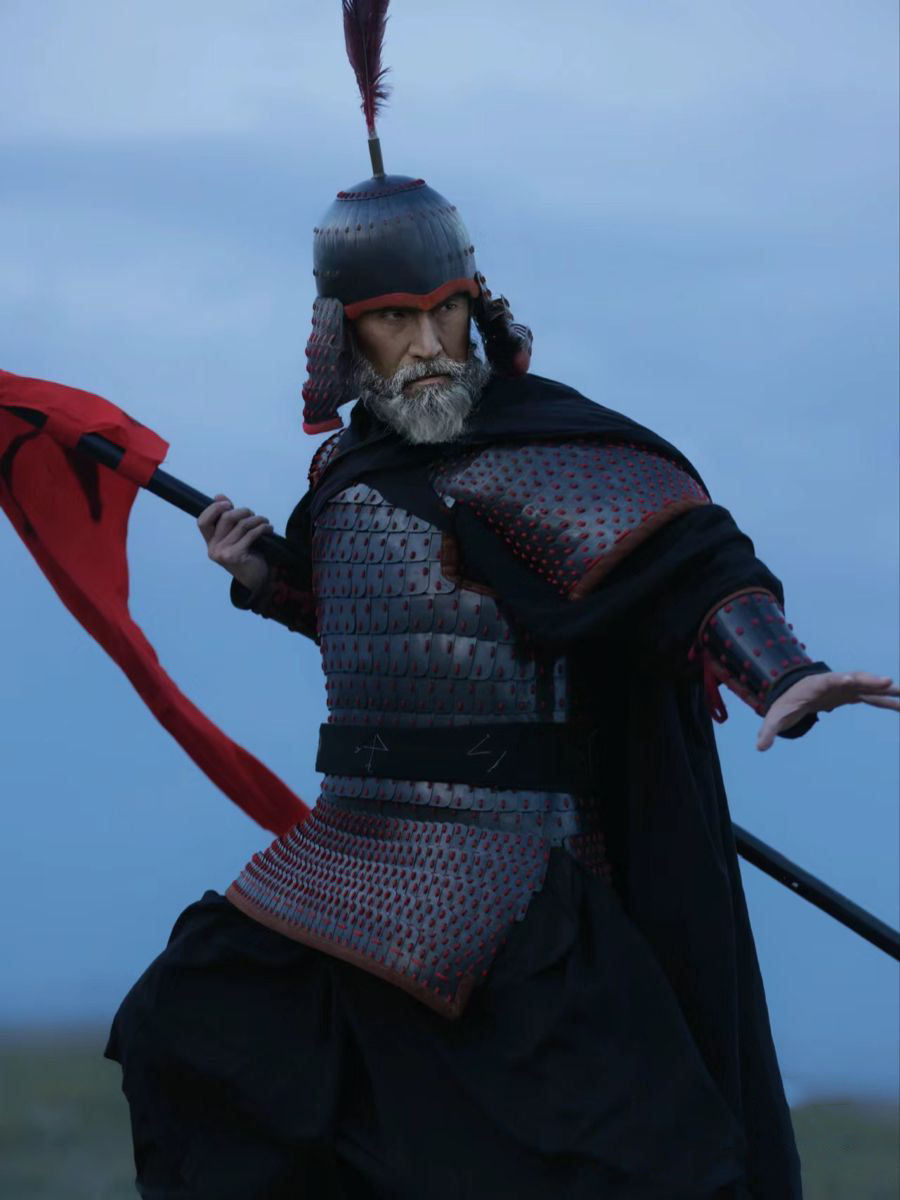Han Dynasty General Armor: 汉将铠甲
Music: 十五从军征
Model: William C 飞廉超
An elderly Han dynasty officer in scale armor with affixed sleeves. Like many Han era armors, pauldron and sleeves are built in on the armor itself and sewn into the scale coat. The helmet body is formed by riveting long strips of lamellar, and the lower part (neck guard) is laced by small scale. Unlike the heaviest of Western Han soldiers, which featured built in sleeves of scales, this set of officer's armor was relatively light. These armors allow the wearer to strap them over long- sleeved robes.
THE HAN GREAT WALL- OFFENSE & DEFENSE
There were vast expansions to the Great Wall during the Han dynasty, which significantly stretched the walls westward. Instead of being content with the diagonal shape of the Qin Great Walls, as the Han conquered the Hexi Corridor and the Tarim Basin. Soon the Great Wall expanded into those regions as well. Many layers of the wall popped up around the flat northern loop of the Yellow River so that the whole frontier became a fortress (or Barbican) for the Han.
Han dynasty Great Wall: The wall also extended across the back of the narrow Hexi Corridor and into the Tarim Basin itself, linking with key oasis cities of Loulan (Kroran) and Quici (Kucha.) It is paramount to note that the Tarim lap of the Han Great Walls were built directly into one of the most uninhabitable biomes on planet Earth, right across long stretches of the deadly dune sea of the Taklamakan desert itself. All parts of this network made clever use of the terrain and comprehensively connected northern China in one defense.
HAN GENERAL'S ARMOR
Unlike the heaviest of Western Han soldiers, which featured built in sleeves of scales, this set of officer's armor was relatively light. These armors allow the wearer to strap them over long- sleeved robes.
Han dynasty armors are frequently attached to pauldrons. The heavier armors have a full armored sleeve to protect against the usually vulnerable armpits of the lamellar wearer. Many Han armors, such as the 襟领铠 Jīn lǐng kǎi, "Collared" lamellar armor also have raised back and side collars to protect against glancing sword slashes towards the wearer's neck.
Emperor Wu, the warrior emperor of Han was noted for his aggressive expansions in all directions which resulted in the Han empire effectively doubling its size. At its height, the Empire's borders spanned from the Tarim Basin and the Fergana Valley in the west, to central Korea in the east, and to northern Vietnam in the south. His posthumous honorific: "Wu" 武 ~ (Literally Translated as the "Martial One" or the "Warrior") by his successors, was attributed in regards to his vigorous campaigns.
Music: Service and Sacrifice
It was during this era that a famous poem emerged. The poem is titled "Joined the Army at Fifteen." The poem describes a soldier joining the army at the tender age of fifteen, then returning back to the same home at eighty after his tour was finally over. It's a bitter poem about the harrowing trauma of war and the dissonance of returning to an empty, starkly different home with no one to relate such an outworldly experience.
"THE OLD SOLDIER'S RETURN" | "JOINED THE ARMY AT FIFTEEN"
I was but fifteen when I left my friends
For distant climes to fight our Country's foe,
And now I'm eighty—back for the first time
To see the home I left so long ago.
Where is the house? I should be near it now,
Yet possibly I may have gone astray;
Long years abroad have blurred the youthful brain,
I'll ask this countryman to point the way.
'The house is yonder—midst those grassy mounds,
Beneath the shade of fir and cypress trees,
And there lie buried all the kith and kin
Of former tillers of these fallow leas.
The veteran sighed and wandered to the house,
And found it overgrown and desolate;
A startled hare fled through the kennel's hole,
And pheasants flew from ceiling beams ornate.
Exhausted by the journey and his grief,
The old man plucked some grain from patches wild,
And mallows from around the courtyard well,
As in the days when but a little child.
But when the homely fare was cooked and spread,
And not a friend to cheer the lonely place,
He rose, and going out to eastward gazed,
While tears flowed down his worn and furrowed face.





















Comments
Armies became 'professionalized' with the inevitable negative repercussions of the rise of warlords in the late Republic and Eastern Han dynasty. Caesar and Cao Cao are so alike living in such a similar polity.
Better to have a legion that's already there as a rapid response force, that could be rotated there, supported by other legions that can rapidly join in to respond + an entrenched military frontier. And later Diocletian times rapid response reserves on an empire level and a fortified frontier line and response legions.
Similarly this goes for the Han as well, after Bang Chao reexerted Han presence in the west and much of Han's endemic foes from the steppes have been subjugated and vassalized the empire turned inward- there's not point to be armed to the teeth if you have no context to use it.
As for the Chinese one I do consider the massive division of the north and the centuries of loss of a cohesive state as one making the distinction, and I would consider the Sui- Tang to be Early Middle Ages (at least definitive and incontrovertibly by my standard, though I would consider the N Wei / Jin period one too in a more liberal definition) regardless the 16 kingdoms period is a major cut off point for me.
These terms like 'antiquity' or 'late antiquity', Dark Ages, Medieval Period, Early Modern Period, etc, etc. don't apply to the Chinese context. It may apply to The West, but not China.
Just like China as its own terms for its history, ... Three Lord Five Emperors Period, Three Dynasties Period, Imperial Period, etc apply only to China.
If you ask me, if we wanted a universal system to classify time periods, I'd go with a division based on civilization:
Primary Civilization (Late Neolithic to Early Bronze Age)
-Sumeria/Mesopotamia, Harrapan Indus Valley, Egypt and Shang China
Secondary Civilization (Late Bronze to Early Iron Age)
- Assyria/Achaemenid Persia, New Kingdom Egypt, Greece, Rome, Israel, Vedic India and Zhou China
Tertiary Civilization (Late Antiquity to Mongol Conquest)
- Islam, Christendom (France, Spain, England, HRE), Japan, Korea and T'ang/Song China
Quadrinary Civilization
- USA, Revolutionary/Napoleonic France, Soviet Union, European Union and China
Thoughts?